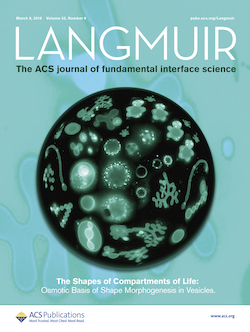James Ho C. S., Padmini Rangamani, Bo Liedberg, Atul N. Parikh, Langmuir 32, 2151–2163, 2016
Feature Article | Cover
 Giant lipid vesicles are topologically closed compartments bounded by semipermeable flexible shells, which isolate femto- to picoliter quantities of the aqueous core from the surrounding bulk. Although water equilibrates readily across vesicular walls (10^–2–10^–3 cm^3 cm^–2 s^–1), the passive permeation of solutes is strongly hindered. Furthermore, because of their large volume compressibility (∼10^9–10^10 N m^–2) and area expansion (10^2–10^3 mN m^–1) moduli, coupled with low bending rigidities (10^–19 N m), vesicular shells bend readily but resist volume compression and tolerate only a limited area expansion (∼5%). Consequently, vesicles experiencing solute concentration gradients dissipate the available chemical energy through the osmotic movement of water, producing dramatic shape transformations driven by surface-area–volume changes and sustained by the incompressibility of water and the flexible membrane interface. Upon immersion in a hypertonic bath, an increased surface-area–volume ratio promotes large-scale morphological remodeling, reducing symmetry and stabilizing unusual shapes determined, at equilibrium, by the minimal bending-energy configurations. By contrast, when subjected to a hypotonic bath, walls of giant vesicles lose their thermal undulation, accumulate mechanical tension, and, beyond a threshold swelling, exhibit remarkable oscillatory swell–burst cycles, with the latter characterized by damped, periodic oscillations in vesicle size, membrane tension, and phase behavior. This cyclical pattern of the osmotic influx of water, pressure, membrane tension, pore formation, and solute efflux suggests quasi-homeostatic self-regulatory behavior allowing vesicular compartments produced from simple molecular components, namely, water, osmolytes, and lipids, to sense and regulate their microenvironment in a negative feedback loop.
Giant lipid vesicles are topologically closed compartments bounded by semipermeable flexible shells, which isolate femto- to picoliter quantities of the aqueous core from the surrounding bulk. Although water equilibrates readily across vesicular walls (10^–2–10^–3 cm^3 cm^–2 s^–1), the passive permeation of solutes is strongly hindered. Furthermore, because of their large volume compressibility (∼10^9–10^10 N m^–2) and area expansion (10^2–10^3 mN m^–1) moduli, coupled with low bending rigidities (10^–19 N m), vesicular shells bend readily but resist volume compression and tolerate only a limited area expansion (∼5%). Consequently, vesicles experiencing solute concentration gradients dissipate the available chemical energy through the osmotic movement of water, producing dramatic shape transformations driven by surface-area–volume changes and sustained by the incompressibility of water and the flexible membrane interface. Upon immersion in a hypertonic bath, an increased surface-area–volume ratio promotes large-scale morphological remodeling, reducing symmetry and stabilizing unusual shapes determined, at equilibrium, by the minimal bending-energy configurations. By contrast, when subjected to a hypotonic bath, walls of giant vesicles lose their thermal undulation, accumulate mechanical tension, and, beyond a threshold swelling, exhibit remarkable oscillatory swell–burst cycles, with the latter characterized by damped, periodic oscillations in vesicle size, membrane tension, and phase behavior. This cyclical pattern of the osmotic influx of water, pressure, membrane tension, pore formation, and solute efflux suggests quasi-homeostatic self-regulatory behavior allowing vesicular compartments produced from simple molecular components, namely, water, osmolytes, and lipids, to sense and regulate their microenvironment in a negative feedback loop.